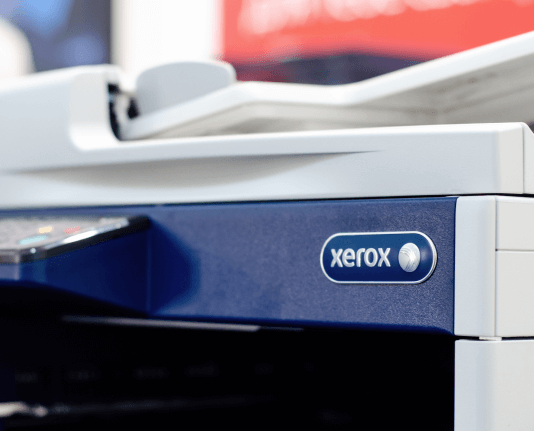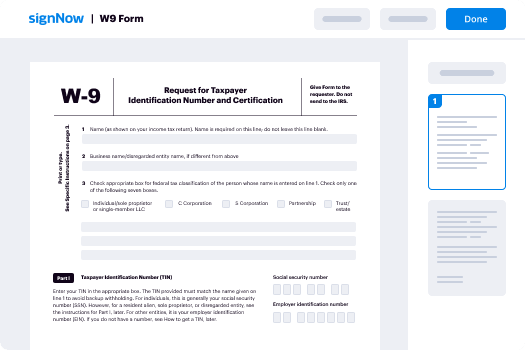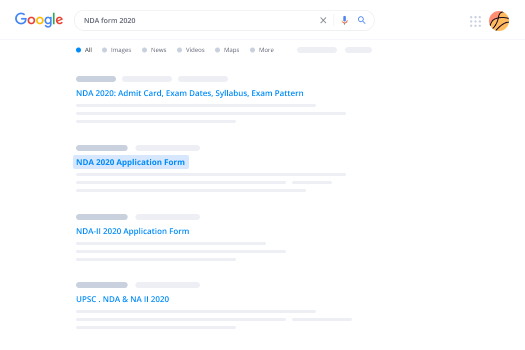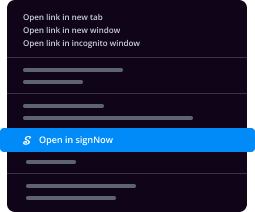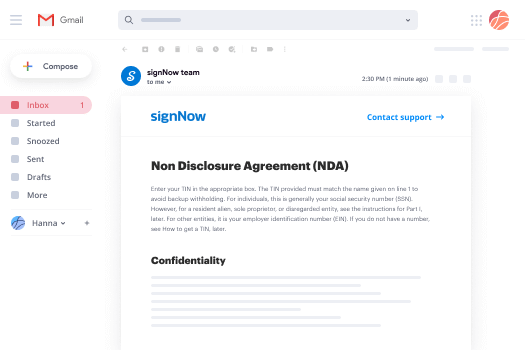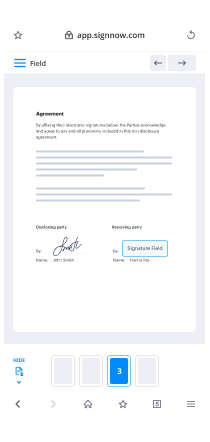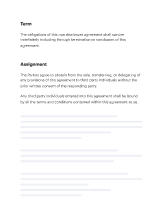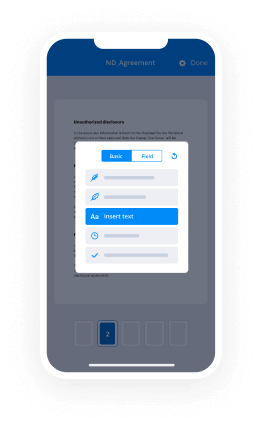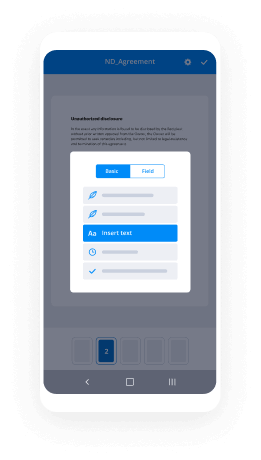Can I Integrate Electronic signature in CMS
Contact Sales
Make the most out of your eSignature workflows with airSlate SignNow
Extensive suite of eSignature tools
Robust integration and API capabilities
Advanced security and compliance
Various collaboration tools
Enjoyable and stress-free signing experience
Extensive support
Keep your eSignature workflows on track
Our user reviews speak for themselves






Grasping CMS Integration with airSlate SignNow
CMS integration is vital for organizations aiming to optimize document handling and signing workflows. airSlate SignNow provides a powerful platform that enables users to transmit and eSign documents effectively, making it an excellent option for firms seeking to improve their operational processes. This guide will lead you through the key steps to effectively use airSlate SignNow.
Steps to Execute CMS Integration with airSlate SignNow
- Launch your browser and go to the airSlate SignNow site.
- Register for a free trial or log into your pre-existing account.
- Choose the document you intend to sign or send for signature and upload it to the platform.
- If you foresee using this document later, save it as a template for straightforward access.
- Open the uploaded document to perform necessary adjustments, such as adding fillable fields or inserting data.
- Sign the document and add signature fields for the recipients to complete.
- Click 'Continue' to complete the setup and dispatch an eSignature invitation.
By utilizing airSlate SignNow, companies can reap substantial advantages, including an admirable return on investment, due to its all-encompassing feature set designed to accommodate diverse budgets. Furthermore, its user-friendly interface facilitates easy adoption and scaling of document processes for small and medium-sized enterprises without complications.
In summary, airSlate SignNow provides a clear pricing model with no hidden charges, ensuring that you are aware of what your investment involves. With around-the-clock customer support available for all paid subscriptions, incorporating this tool into your CMS can transform your document management workflows. Begin your free trial now to witness the advantages directly!
How it works
Rate your experience
-
Best ROI. Our customers achieve an average 7x ROI within the first six months.
-
Scales with your use cases. From SMBs to mid-market, airSlate SignNow delivers results for businesses of all sizes.
-
Intuitive UI and API. Sign and send documents from your apps in minutes.
A smarter way to work: —how to industry sign banking integrate
FAQs
-
What is CMS integration with airSlate SignNow?
CMS integration with airSlate SignNow allows businesses to connect their content management systems seamlessly with our eSigning platform. This means you can automate document workflows directly from your CMS, improving efficiency and saving time. By utilizing CMS integration, you can easily manage, send, and sign documents without leaving your content management environment.
-
How can CMS integration benefit my business?
Implementing CMS integration with airSlate SignNow streamlines your document processes, reducing manual work and minimizing errors. This integration enhances collaboration by allowing teams to send and track documents directly from their CMS. Ultimately, the benefits include increased productivity, faster turnaround times, and a more organized document management system.
-
What types of CMS platforms can integrate with airSlate SignNow?
airSlate SignNow supports integration with various popular CMS platforms, including WordPress, Joomla, and Drupal. This compatibility allows businesses with different content management systems to leverage our eSigning capabilities. Check our integration documentation for a comprehensive list of supported CMS platforms.
-
Is there a cost associated with CMS integration in airSlate SignNow?
While airSlate SignNow offers various pricing plans, CMS integration features are typically included in the higher-tier packages. This means you can access CMS integration as part of your subscription, enhancing the value of your investment. For detailed pricing information, please visit our pricing page.
-
Can I customize the CMS integration to fit my business needs?
Yes, airSlate SignNow provides customizable CMS integration options to cater to your business requirements. You can adjust workflows, document templates, and signing processes within your CMS environment to ensure they align with your operational needs. This flexibility helps you create a tailored experience that suits your team.
-
How secure is the CMS integration with airSlate SignNow?
Security is a top priority at airSlate SignNow, and our CMS integration is designed to ensure your data remains protected. We utilize advanced encryption methods and comply with industry standards to safeguard your documents during transmission and storage. This means you can confidently manage sensitive information through our CMS integration.
-
What support is available for setting up CMS integration with airSlate SignNow?
Our customer support team is available to assist you with the setup of CMS integration with airSlate SignNow. We offer detailed documentation, tutorials, and responsive support to guide you through the integration process. Whether you're a beginner or an experienced user, our resources will help you get started smoothly.
-
What are the CMS requirements for electronic signatures?
Your question indicates you may be planning to just build your own system; you may wish to consider the need for a neutral 3rd party to hold documents in event enforcement of contract is needed.All electronic signatures should ideally haveMethods of verifying claims of identity - ranging from as low-end and simple as verifying an email address to as high end as attachment of video clips indicating agreement and showing the signor’s face, with end-to-end encryption, browser / device fingerprinting along with IP Geolocation, and multiple methods of password delivery (i.e. like 2-step authorization common with FB/G+). What’s legally required as per the E-SIGN act seems a bit vague, but best practices vary by industry; HIPAA medical compliance is more strict for example.Retrieval and storage by a neutral 3rd party as an immutable / un-alterable digital file, with audit trail for the above meta data. Note for enforcement reasons - court - you’d ideally need a 3rd party who can and will show up in court or handle depositions as needed as an expert witness, should either party deny having signed the documents. If you are one party to the signature, but also the holder of the signed document, your legal enforcement options are inferior, and proving the document immutable might be called into question.I’m a coder, not an attorney; this is not legal advice but simply helpful information that may point you in the right direction to the best of my ability.Relevant: An electronic Signature is technically 2 parts:A claim to be a person, and if relevant, a claim that the person is duly authorized to sign on behalf of that organization i.e. officer of a company. In the world of ink signatures, the uniqueness of someone’s ink signature, combined with the situation help prove the person’s identity.Agreement, to whatever terms are in your contract or agreement.Hope that helps. Swift Signature is our solution, which is one of many, and which is ideal for you will vary by your specific needs (i.e. HIPAA compliance, re-usable templates, etc.) - we have a Wordpress plugin that makes for an easy, free option at Electronic Signature by SwiftCloud
-
How can one integrate CMS with Salesforce?
If you want to integrate CMS with Salesforce, here is a solution for you.Team Webkul has designed a Salesforce Application called CMSKUL which is a paramount cloud based CMS solution built native on Salesforce platform furnishes a wide range of digital exposures which includes an enhanced customer portal, templates, creation of articles listing with menu items. Hence get an easy and personified portal with a potential in-built CMS in order to drive the involvement of traffic in your digital world.CSMKUL is a content management system that fully integrates with Salesforce and Sites. The basic idea behind the application is to put Content Management System on Cloud similar to the way Ecommerce has been put into the cloud.FeaturesYour webmaster can define templates that define the look and feel of your website using standard technologies.Business users can then use these templates to create/edit pages on your website.100% cloud based CMS.A pair of customized templates.Deliver designed website/portal which includes the display of 17 social icons, concept of geo location, image slider and video uploading.Facilitated with the concept of displaying menus and articles.Provision of enhanced Customer portal facility.Use cloud to centralize data and availing the facilities of Salesforce.Built native to Salesforce platform.WHY CMSKUL?Smooth and flawless digital platform built on Salesforce AppCloud.Deliver the advantage of CMS in Salesforce, data and workflow management, prompt integration providing digital web and mobile experience to flourish the business process.Effectual and individualized experience with the concept of retention marketing.Independent of 3rd-party hosting, maintenance cost and involvement of agents/implementer.Installation Link:https://appexchange.salesforce.c...For a better understanding regarding its features, configuration and setup, you can refer to Webkul blog through the link below:Salesforce CMSKULFeel free to contact us anytime if you have any issue in configuration of the App.C : +1-9143521614 Skype ID: Webkul.salesforceThanks
-
How do I integrate a CMS with Bootstrap?
Yes go with an off-the-shelf cms like wordpress or drupal or perch or maybe even ghost if the site is simple enough…To be honest I build wordpress themes from scratch all the time, but if you have a lot of data endpoints / complex interrelation of content types you might be better off with drupal… Though it has a higher learning cost.Possibly wordpress then, as others have suggested.Luckily there are some videos that teach you EXACTLY how to convert a static bootstrap site to wordpress editable theme… But be prepared that it’s an unavoidable learning process of diving deep into the templati...
-
How can I integrate a mobile application with CMS?
Here is a complete guide to managing content with a mobile CMS and it teaches you how to create a mobile CMS using ButterCMS and Flutter, Google’s mobile cross-platform SDK.
-
How can I integrate a CMS into a custom web application?
Depends of CMS, your web app and level of integration. Do you want a common sign-in? That would depend on how you store/mange accounts in your app and how CMS does it. Do you want design/template integration? Unless your app can inherit front-end from the CMS template, you're probably going to need to just "match" the designs. Do you want deep integration, where your app works like a CMS plugin/module/extension? Grab the CMS API and see what it takes to turn your App into the module.
-
Is electronic signature legally binding in India?
Yes, e-signatures are legally valid in India. In fact, e-signatures have been recognized by the Indian law, with the passage of the Information Technology Act in year 2000.As per the IT Act, two types of signatures have the same legal status as handwritten signatures. These primarily include:(i) Digital Signatures: In this case, the signer is issued a long-term (1 to 2 year) certificate based digital ID stored on a USB token that can be used along with a personal PIN to sign a document.Note: Previously, the signer was issued a long-term (1 to 2 year) certificate based digital ID stored on a USB token that could be used along with a personal PIN to sign a document digitally. Now with Aadhaar, that complicated procedure isn’t required anymore. You can simply use signNow’s Aadhaar eSign to create a digital signature on the fly using your Aadhaar ID(ii) Electronic signatures: These electronic signatures combine Aadhaar identity number with an electronic Know-Your-Customer (eKYC) method (which includes sending an One-Time-Passcode to the mobile number linked to the Aadhaar card for verification)These Aadhaar based e-signatures and digital signatures are valid as long as they satisfy these conditions:(i) Electronic signatures must be uniquely linked to the person signing the document. (in the case of Aadhaar based signatures, they are linked by the unique Aadhaar ID)(ii) At the time if signing, the signatory must have control over the data used to generate the electronic signature (for eg: they should be able to directly affix the electronic signature to the document)(iii) There should be an audit trail of the steps taken during the signing the process(iv) In the case of digital signatures, signer certificates must be issued by signNowing Authority recognized by the Controller of signNowing Authorities appointed under the IT Act.Few of the exceptional cases in which documents cannot be signed electronically and must be executed using traditional handwritten signatures include:(i) Negotiable instruments such as a bill of exchange or a promissory note(ii) Powers of attorney(iii) Trust deeds(iv) Wills and any other testamentary disposition(v) Real-estate contracts such as leases or sales agreements.If you are looking to get legally compliant electronic signatures on contracts, invoices, quotes etc., try signNow, India’s first Aadhaar eSign solution that offers a complete fill-and-sign functionality with business workflows. Thus allowing users to finish their documents in one go.Here’s an informative ebook that will give you a brief overview of everything you need to know about electronic signature laws in some of the largest economies around the world: The Complete Guide to Electronic Signature Laws
-
What blogging platform (not CMS) can I integrate in a self hosted website?
You can likely install a few different blog options that can live as a subdomain or directory within in existing, self-hosted domain. …I think that’s what you are trying to solve.As mentioned else where - blogging software is a sub-set of CMS. So many of these options use the term ‘CMS’ in descriptions to explain how the software works. It’s usually a matter of telling the software its home will be within a /directory/WordPress.org is an obvious option.TextPattern - is potentially an option since it’s a blogger-centric option that is easy to get started quickly.There are many others out there… so it’s always advisable to do more research.I think Drupal and Joomla are likely NOT options for you given they take more effort to get going.…Lastly, I’d encourage you to write out all the content and use cases you *might* want to tackle with your blog. If there are any cases with imagery, videos, special functionality, or 3rd party integrations - you want to future proof. WordPress is often one of best options after doing this exercise given the open source core, vibrant community support (design & code), and the modular design.Good luck!
Trusted esignature solution— what our customers are saying
Get legally-binding signatures now!
Related searches to Can I Integrate Electronic signature in CMS
Frequently asked questions
How do i add an electronic signature to a word document?
How do they know an electronic signature is actually you?
How to sign or edit a pdf document?
Get more for Can I Integrate Electronic signature in CMS
Find out other Can I Integrate Electronic signature in CMS
- Memorial hermann work form
- How fill out valic transfer rollover out form 2015 sample
- Annulment paper form
- Disadvantaged background form
- Surrey form
- Electrical work form
- Xnxxinlin form
- Mount washington college transcripts form
- Elf 31 number fom download form
- Browab form
- Nmc international travel declaration form
- Healthcaregov appeal request form
- Personal reference form lara mi department of licensing dleg state mi
- Personal reference form
- Employee rosters lara mi department of licensing and dleg state mi form
- Michigan lara form
- Box 30243 lansing mi 48909 dleg state mi form
- Ssn verification form ssa 89 citizens bank
- Mortgage fraud is investigated by the fbi general bb form
- Eeo monthly employment utilization report division of housing nyshcr form

